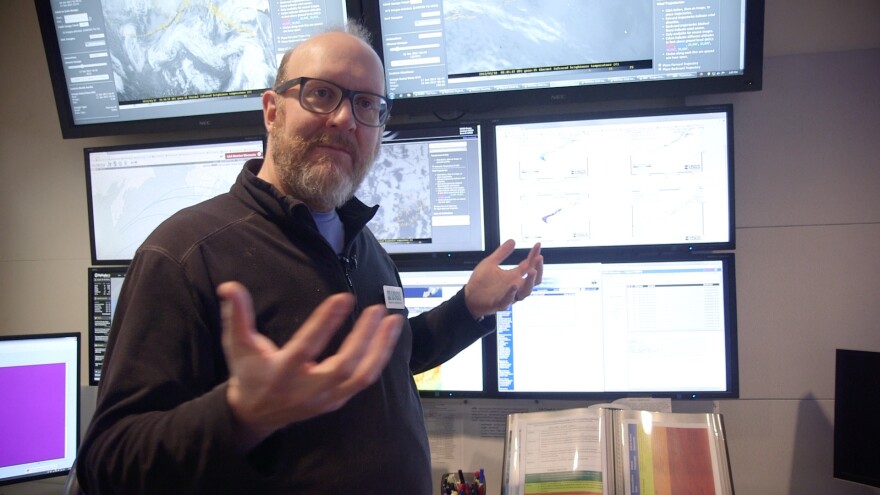Across Alaska there are monitoring instruments on 31 of the most active volcanoes, but there’s nothing on the one that’s erupting now.
Bogoslof volcano is on a tiny uninhabited island in the middle of the Bering Sea. Since mid-December, Bogoslof has erupted more than two dozen times. With eruptions spraying ash up to 35,000 feet in the air, the Federal Aviation Administration has banned flights from flying over it.
“Typically they’ve happened late at night,” said Dave Schneider, a geophysicist at the U.S. Geological Survey, USGS, in Anchorage. “Volcanoes are like babies, they never come at a convenient time.”
He says unpredictable and frequent eruptions have kept scientists up around the clock doing status checks.
But technology has gotten to the point where the crew can do most monitoring from anywhere, including their homes, and the team can act quickly when the need arises.
Last year Pavlof, one of Alaska’s most active volcanoes, had a surprise eruption that caught Schneider at the Easter dinner table.
“You know, you sort of move aside the ham, you open up your laptop. and you take a look at what’s going on,” Schneider said. “That’s just what we do.”
But watching Bogoslof is more tricky than Pavlof due to its remoteness and lack of an on-island monitoring network.
Bogoslof belongs to a rare class of submarine volcanoes that have erupted through the ocean surface. There are only a handful around the world, so researchers at the Alaska Volcano Observatory, or AVO, are looking for clues in the history of a similar volcanoes, like Surtsey in Iceland.
Schneider says there aren’t really any options for monitors on Bogoslof because the island is so small.
“It would be difficult to actually put much a monitoring network on there,” Schneider said. “If there had been instruments on there, they likely would have been destroyed by seismic activity at this point.”
The decision on where the AVO places equipment Schneider says is based on how much threat a volcano poses to nearby people and property.
There’s all sorts of different tools the organization can use to monitor volcanic activity, from seismic instruments to satellites to infrasound data. In the case of Bogoslof, they’re not in the business of predicting eruptions.
Schneider has worked in Alaska for two decades and says Bogoslof’s eruption is unlike anything he’s seen in the state.
“We don’t have any other experience with this type of eruption style with a vent through the ocean during my time period in Alaska,” Schneider said. “There were no nearby seismometers, like we have now, that would allow us to do this kind of analysis that we are currently conducting.”
So the ongoing explosions and seismic activity at Bogoslof are writing the history books for what eruptions at this volcano look like. But the distant monitoring instruments, on Umnak Island and in Sand Point, are only picking up the largest seismic events.
Chris Waythomas is a geologist for USGS. While he’s glad there’s a network to support monitoring of Bogoslof — 24 years after its last eruption — he doesn’t think it’s enough.
“I think we’re still missing a fair bit of the story,” Waythomas said. “I think there’s a lot going on out there that we’re not catching, so that’s a little frustrating.”
One thing the team missed was the date of the first eruption back in December. AVO first noticed the eruption on December 20th, after a pilot reported an ash plume. But looking back at the seismic record, they now believe activity began more than a week earlier.
Waythomas says watching the eruption progress is interesting, but he’s more excited for what comes next.
“What we are doing now is the real time volcano monitoring and preliminary interpretation of the data streams,” Waythomas said. “A lot of the story remains to be told.”
Waythomas says hundreds of papers can be written after eruptions like this one. He’s hoping once the volcano cools off and Bogoslof Island is safe, he’ll be able to check it out for himself.








